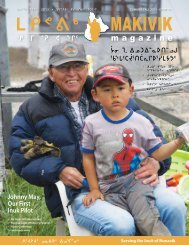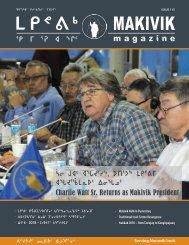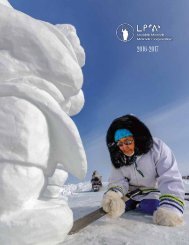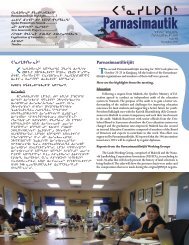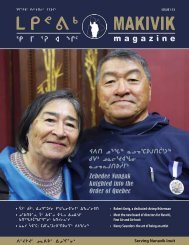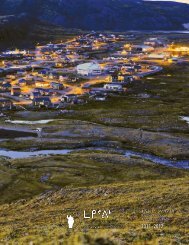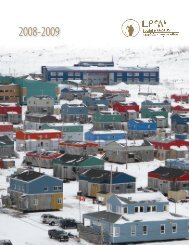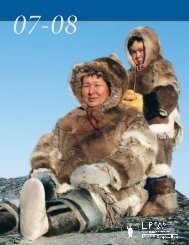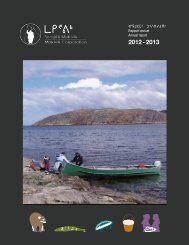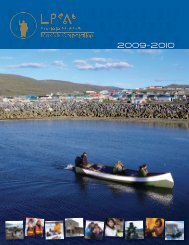Makivik Magazine Issue 100
You also want an ePaper? Increase the reach of your titles
YUMPU automatically turns print PDFs into web optimized ePapers that Google loves.
mr[4 eu3Dxq5<br />
14<br />
ᖃᐅᔭᖃᐅᑎᕕᓂᒋᐊ9˜4.<br />
More qajaq stands.<br />
x7mlrbsozJu €3eh3bsmK5 xr8Nc3ht4 !-übu4 d7j5<br />
brio7u4. Ì4fx wlxi xr8Nj5 x5gxht4 w5y?[[î5<br />
Wbc3g5 wloµzi4 Ü?9M‰3ym5yxht4 vb[iq5<br />
w5y?[5bc1qggxat9lQ5. sW3¯u kNg3oi N2Xbsc5bymJ5<br />
wms2 yˆiZ˜4 ò3g÷u miê8Nsi3nu. Ntzb et9lxzi<br />
vt3hymJi4 s/C7mE5bc3ht4 d˜os3bsmJi4 ñ5g÷u4<br />
s/C3u4 hNb5y/sym§[isZlxurx6. xgi5 sW3¯u<br />
kNg3oQ/sc5bymJ5 xbsy3u4 Öà5gbø8Ns÷3g5. bm4fx<br />
xq3Cnoxaym1qQxq5 bf5nsJ5 bf5nsJtc3Sl w9otc-<br />
1qifuk5. x5psZt9l c3m[i3k5 Wbc3umb bm4fx<br />
kNi Nt3NJxi yˆa1qi3nü5gi. bm4fx x7mlrbsoz5ht4<br />
N2Xt3bsc5bMs3g[î5 d˜c3iq5©Qxq5 bf5nsuJ5<br />
whmN1axS9l wk8k5 vt1z[s?5g[isQxq5. xyq5<br />
s/ê5 bµi kNü5g5 x7mlrbsoz7uht4 Ì4fx N2Xt3ymJ5<br />
ᐅᔭᕃᑦ ᐊᒻᒪᓗᑭᑕᐅᓕᖓᔪᑦ.<br />
A circle of rocks.<br />
When they wanted to catch a fox, Inuit built<br />
fox traps made of stones. They used rocks that had<br />
a flat side that formed the inside wall of a circular<br />
structure whose floor was about two metres<br />
in diameter. The diameter became smaller going<br />
towards the top, which was left open. Rocks were<br />
placed all around the structure to allow the fox<br />
to have access to the hole. Bait was put into the<br />
trap and the hole was covered with the wings of<br />
a bird. The curious fox fell through the camouflaged<br />
wings and became trapped.<br />
To get caribou, Inuit erected many individual<br />
rocks close to one another in a strategic place.<br />
Those can be seen today in a few places on the<br />
tundra, but nobody uses them now.<br />
At other times, Inuit hunted geese by hiding<br />
behind blinds made of rocks on the tops of hills.<br />
They waited patiently for the birds to fly close<br />
during late spring and early fall.<br />
To fish in rivers during the fall, Inuit built<br />
weirs of rocks in ideal areas when the migrating<br />
Arctic char swam upstream from the salt sea. The<br />
bm4fN1zoµ6 xJá8iXs÷3g5 Ö4fx<br />
hN[[is7m¯b NlN3g5 s/ê5 wi9MbsmJ5<br />
x7mlrbsozJu4 szy5©Zt4 wKp[7j5. Ì4fxl<br />
s/ê5 x7mlrbsozJoxamJ5 %-^ übi4<br />
grj5 bric3ht4 x7mlrbsozJu €3eh3bsmK5<br />
xr8Nc3ht4 !-übu4 d7j5 brio7u4.<br />
What is perhaps most interesting is that there are mysterious<br />
ruins of rocks that form circles in some spots around the vicinity<br />
of Ivujivik. These can be as wide as five or six metres in diameter,<br />
having walls of huge boulders that are a metre high.<br />
confused fish had difficulty finding the route. The<br />
men, women and youth cooperated in the catching<br />
of the fish, using spears. A new fish trap was<br />
built every year because rocks that had been<br />
put up in the fall were damaged by many gigantic<br />
pieces of ice that rushed downstream during<br />
the following spring thaw.<br />
What is perhaps most interesting is that there<br />
are mysterious ruins of rocks that form circles in<br />
some spots around the vicinity of Ivujivik. These<br />
can be as wide as five or six metres in diameter,<br />
having walls of huge boulders that are a metre<br />
high. Touching those walls inside the structure<br />
are seating platforms that are all around the circumference<br />
except at the entrance part. They had<br />
been erected near the shore on flat rock surfaces<br />
in a summer camp. There are pieces of big rocks<br />
in the middle with a flat top probably for displaying<br />
something. There appears to be only one such<br />
structure in each of the ruins of a summer camp.<br />
It’s likely that they were not meant to be homes<br />
because what would have been the sleeping<br />
platform is missing. And they are different from






